
Wine Culture and Information since 2002 - Volume 22
 Wine Culture and Information since 2002 - Volume 22 |
|
Issue 228, May 2023 |
Contents |
|
|
Who is Afraid of the Barrique? |
|
I frequently think how the world of wine has changed over the last twenty years, in some cases, very quickly. It is unavoidable not to think about how certain “fads” were born, raised and exalted to the extreme, and then began their decline, therefore disowned, no less, considered as phenomena that it is good to keep hidden, even when they are part of the winemaking process used. These behaviours practically occur in every wine-growing country in the world, however, in Italy it seems to me this is a recurring phenomenon and changing with the fads, indeed, opportunities, of the moment. When a new enological fad or trend appears, I always think it is going to be a phenomenon waiting to fall into oblivion with a lot of fierce hostility. When this happens – that is, the occurrence of the more or less inglorious end – the old Latin saying always comes to my mind: sic transit gloria mundi (Thus passes the glory of the world). One of these “phenomena” is undeniably the barrique. Do you remember when, in the 1990s, this magical word was enough to sell a wine, even of dubious quality? In Italy, many bottles showed off, prominently on the labels, even the abominable neologism barriccato – or barricato (meaning “aged in barrique”) – to emphasize that divine nectar promised heavenly emotions for having being kissed by the barrique. Grape composition? It wasn't important: it's barriccato, everything else is irrelevant and insignificant. Every winery, in case it wanted to enter the enological heaven, had to show off the barriques, both in the aging rooms and on the labels. In those days, when visiting the wineries of certain producers, the sight of the magical Bordeaux-style casks was followed by the solemn announcement of the number of barriques owned. Moreover, in some wineries the barrique was the only type of barrel used. Any wooden container with a volume greater than 225 liters had been sacrificed in favor of the magic barrique. There was also a sort of competition in showing off the number of months spent by the wine inside the barrique, so much so that – in many cases – the poor wine succumbed under the weight of so much wood that erased its identity and quality. Who cares about that, it is barriccato. Indeed, in some cases, the producer – while tasting his or her wines – triumphantly and with a quite high pride emphasized the aroma and the flavor of the barrique in the wines. It was a praise, unquestionable proof of the highest quality. A sort of competition which inevitably led to the exasperation of organoleptic homologation as, in many cases, the wine was almost indistinguishable from the aromas transferred from the barrique. All the wines were the same, all proudly barriccato with the noble and cumbersome oak smell. There seemed to be no break from the barrique rush and producers, in order not to be outdone by others, cheerfully poured the most disparate and unfortunate wines into the small Bordeaux barrels looking forward in the coveted enological miracle. As a consequence, a huge quantity of grapes, slender and thin wines ended up being poured in the barrique, totally crushed by the weight and personality of the new and well-toasted oak, with the result of producing an alcoholic infusion with a wood flavor and which were soon called “carpenter's wines”. At the beginning – let's admit it – these wines were also “fun” to taste, despite the outrageous enological result, and soon they ended up boring and exasperating everyone, producers included. I remember, in those days, every time I tasted a wine strongly marked by what the barrique had copiously given the wine, to my mind always came the famous quote of Émile Peynaud, the great French winemaker, one of the most influential and important of the last century, which has left us – not least – a rich and important enological bibliography. The great French winemaker, among the many things he said about the use of wood in enology, said «the best wine aged in wood is the one where you cannot perceive the wood». He also said «the wood had to be used in the wines the way aromatic herbs are used in cooking, to help the other aromas stand out better». Following these quotes by Émile Peynaud, another famous saying of the French winemaker promptly came to my mind: «It is you (consumers) who in a certain sense make quality. If there are bad wines it is because there are bad drinkers. Taste conforms to the crudeness of the intellect: everyone drinks the wine he or she deserves.» Evidently, in those days, the taste of wine drinkers – good or bad – greatly appreciated the taste of wood. When a product is liked and sold, of course, it continues to be produced, with all due respect to Émile Peynaud and his teachings. The fad for carpenter's wines – this is how wood-flavored wines were jokingly called in those days – regarded not only Italy, but also other wine-producing countries of the world, such as the United States of America, Australia, Chile and Spain. In some cases, even France – which is the homeland of the Barrique – was not saved by this fad and it happened to have in the glass some French wines unexpectedly slaughtered by the barrique. This phenomenon, like I was saying, has progressively led to the organoleptic exasperation of the wines, so much so that from the enthusiasm we progressively passed to the indignant refusal. Since the beginning of the 2000s the “barrique fad” was heading towards its sunset as well as the horrendous term “barriccato” disappeared from the labels. The barrique, blamed of being the primary culprit of the sensorial homologation of wines, had to somehow disappear from the consumers' imagination. But not in that of the producers who, despite the infamous accusation of homologation, have continued – and continue – to use it. Of course, not in the way they did in the past, they have probably and finally understood the real role of the barrique, which certainly is not that of obscenely altering the sensorial characteristics of wine. Producers, today, continue to use the barrique but, in many cases, they are even afraid to admit it, to such an extent that, often, they even avoid mentioning it in the production sheets of a wine. In order not to disturb the serenity of enthusiasts who, in the meantime, have developed a repulsion and aversion to the barrique, who still believe it is the absolute evil, many producers prefer to call it with more acceptable names. On the back labels of the wines and in the relative production sheets, we can see an interesting and flourishing use, often even imaginative, not least, misleading, of alternative terms alluding to the barrique without ever expressly mentioning it. Small wood, small barrels, oak barrels, carato barrels, small oak and so on. In the case of carato – the typical small Italian barrel – the term is clearly inappropriate and misleading, both for the volume and for the use when compared to the barrique. In any case, this is always better than mentioning the dreaded 225 liter Bordeaux barrel and arousing the indignation of the wine “purists” who only dream of uncontaminated and “true” nectars in their glasses, in accordance with the most rigorous and orthodox of traditions. Whenever I read these “acrobatic” attempts to sugar the pill, avoiding the word barrique but alluding directly to it, this always makes me smile. It is just like what happens on the labels of certain food preparations in which monosodium glutamate is present – an ingredient added to the black list of true connoisseurs of good food since quite long time – and everyone is happy and reassured when they don't read it on the labels but find, for example, yeast extract. Happy and reassured, they celebrate the good news with a tasty chip of aged Parmesan cheese, in which monosodium glutamate is notoriously and naturally contained and not added. I think it is superfluous to remember the barrique – in itself – is not at fault, rather the fault goes to the responsibility of the ones who used it, or continues to use it, in an inappropriate or excessive way. The barrique is neither good nor bad: it is simply a wine making tool, I would add, very important and useful, and when used in an appropriate and correct way, it is – for certain wines – fundamental and essential. Even when it is affectionately called small cask, small oak or small barrel, “it six of one, half a dozen of the other”. Antonello Biancalana
|
||||
Contrasts of Amelia Malvasia and Collio Ribolla GiallaTwo white grapes compared in the glasses of this month's tasting. Varieties having ancient origins, interpreted in the lands of Umbria and Friuli-Venezia Giulia. |
|
The history of wine grapes is always fascinating and surprising, often revealing unsuspected journeys reaching a place from distant places, sometimes also introducing new styles, viticultural and enological technologies. The reasons why grapes travel from one place to another, frequently, more than one, are generally and historically known. One of the most recurring reasons is due to colonization, with the “conquering people” introducing – besides their own cultures and habits – also their wine grapes into the new colonies. In this regard, as far as the enological history of Italy is concerned, the contribution given, in this sense, by the ancient Greeks is decidedly significant. As it is widely known, many of the varieties still cultivated today in Italy – in particular in the southern territory of the country – are evidently of Greek origin. Another reason which led to the introduction of wine varieties in other countries is the consequence of commercial exchanges as well as of travelers, missionaries and merchants, who, returning home, brought with them the varieties of the distant places they had visited. In certain cases, the determination of the origin of a grape is not always possible, both because of the lack of reliable and verifiable information, as well as for the impossibility of detecting analogies and affinities with other varieties. Last but not least, the history of grapes has sometimes been literally rewritten by the results of researches, in particular those conducted at the genetic level, which have sometimes allowed to confirm or deny the origins of different varieties. The grapes we are going to evaluate in this month's tasting by contrast – Malvasia Bianca and Ribolla Gialla – perfectly represent these two cases. Both varieties identify with the places and territories where they have been grown since time immemorial and in which they have adapted perfectly, so much so that today they are considered native Italian varieties.
|
|
When talking about Malvasia it should always be pointed out that, with this name, it is meant a large family made of both white and red grapes varieties. Furthermore, it is a family of very ancient origins and with a decidedly long and fascinating history. It is no coincidence that Malvasia grapes are among the oldest known varieties, today widely spread all over the Italian territory and, last but not least, in its homeland: Greece. In Italy, the number of varieties defined as “Malvasie” is decidedly vast, so much so that in many regions there is at least one grape belonging to this large family and, last but not least, territories with Denominazione d'Origine Controllata (Denomination of Controlled Origin, DOC) which provide for their use in wines, both white and red. Among the many white berried representatives belonging to this large family, are mentioned Malvasia Bianca Lunga, Malvasia Istriana, Malvasia del Lazio, Malvasia delle Lipari, Malvasia di Candia and Malvasia di Sardegna. Among the red ones, the most known ones are Malvasia Nera, Malvasia Rossa, Malvasia di Casorzo and Malvasia di Schierano. The varieties belonging to the Malvasia family are appreciated, in particular, for the aroma of their wines which, in some cases, directly recall grape juice. This characteristic makes them consider by some as semi-aromatic varieties, even though they do not possess the strength and intensity of the real varieties defined as aromatic. The wine we are going to evaluate this month is, in truth, one of the many produced in Italy with at least one member of the Malvasia family, in particular, the one produced in the territory of Amelia, in Umbria and in the province of Terni. The territory is classified as Denominazione d'Origine Controllata (Denomination of Controlled Origin, DOC), and is among the largest in the region, particularly appreciated for its white and red wines, including monovarietal ones, such as Amelia Malvasia. It is a white wine and, according to the disciplinary, it is produced with at least 85% of Malvasia Toscana, more properly known as Malvasia Bianca Lunga. Amelia Malvasia is generally fermented and aged in inert containers – both steel and cement – however some producers prefer to carry out these operations in wooden barrel as well.
|
||||
|
For a long time, Ribolla Gialla – the famous white berried variety from Friuli-Venezia Giulia – was considered to be an original variety of Kefalonia, Greece, and, specifically, a clone deriving from the historic Robola grape. According to other theories, it has been supposed Ribolla Gialla had been introduced in its historical territory – Friuli-Venezia Giulia and Slovenia – by the ancient Romans. Today, thanks to research conducted on the DNA of Ribolla Gialla, it has been possible to found out the absence of genetic analogies with Robola, thus denying its Greek origin. It is very probable that it is a native variety of Collio, the large hilly area located between Gorizia, in Italy, and Goriška Brda, in Slovenia. It is however certain to be a variety present in this area from time immemorial and of which we have written evidence dated back to 1256, mentioned in a notarial document. Even today, Ribolla Gialla is among the most representative varieties of Collio, both on the Friulian and Slovenian sides. Gorizia Collio, on the Italian side of Friuli-Venezia Giulia, is characterized by a wine production which has always expressed levels of excellence and quality. In this important wine-producing territory of the region are in fact produced some of the most famous white and red wines of Friuli-Venezia Giulia and, among the whites, those produced with the autochthonous Ribolla Gialla definitely stand out. From an enological point of view, this interesting white berried variety is capable of extraordinary interpretations. With this grape, in fact, are successfully produced dry white wines, vinified both in inert containers and in wooden casks, as well as sparkling wines, also with the classic method, with an interesting sensorial profile. Furthermore, Ribolla Gialla is particularly appreciated in the production of white wines which provide for the maceration of the skins in the must, a fundamental technique for the so-called orange wines. The production disciplinary of Collio, just like most of the Italian disciplinary, in the definition of monovarietal wine provides for the use of the indicated variety for a minimum of 85%, a condition which is obviously applied for wines produced with Ribolla Gialla as well.
|
Before starting this month's tasting by contrast, as usual, let's buy the two bottles we will pour into our glasses. The wine to be more difficult to find is certainly Amelia Malvasia, also considering the volumes produced in its territory and the relative presence in the market. Undeniably easier to find a bottle of Collio Ribolla Gialla, as it is one of the most produced wines in the area and, therefore, widely available on the market. In both cases, these are wines which can be found in every good wine shop. For the composition of the two wines – considering what is provided for the respective production disciplinary – we will make sure they are both produced exclusively with the varieties indicated on the label. We will also choose wines fermented and aged in inert containers, possibly steel tanks, therefore excluding any interpretation in cask. As for the vintage, we will make sure to get most recent one. The two wines are poured into their respective tasting glasses at a temperature of 10 °C (50 °F). Let's pour Amelia Malvasia and Collio Ribolla Gialla in the glasses and start this month's tasting by contrast, proceeding – as usual – from the analysis of appearance. The first wine we examine is Amelia Malvasia, therefore, by tilting the glass over a white surface, let's observe its base in order to evaluate the color, which in this wine is clearly pale and brilliant straw yellow. By placing an object in contrast between the glass and the white surface, we clearly see a very high transparency. Let's now pass to the evaluation of nuances, therefore let's observe the wine towards the opening of the glass, where the thickness is thinner. The color which can be observed is greenish yellow, not only a typical shade for wines produced with Malvasia Bianca, but also the sign of its young age. Let's now pass to the evaluation of Collio Ribolla Gialla and – by tilting the glass over the white surface – we can see an intense straw yellow color, deeper than Amelia Malvasia. Also in this case transparency is very high, whereas nuances confirm the straw yellow base color. The olfactory profiles of Amelia Malvasia and Collio Ribolla Gialla are decidedly different and distant from analysis. The grapes used for the production of these wines, in fact, are characterized by olfactory profiles expressing different aromas, although it is possible to perceive some similarities. Malvasia Toscana – variety used, according to its disciplinary, for the Umbrian wine and which should be better called Malvasia Bianca Lunga – is considered by some as a semi-aromatic variety, because of the moderate scent of grape juice which is sometimes perceptible in its wines. In this regard, it should be observed that, when it is perceived, the aroma of grape juice is never as intense and clear as the one perceived in properly defined aromatic grapes. The olfactory profile of Ribolla Gialla, on the other hand, does not have any quality that can recall aromatic varieties. In both cases, these are grapes with excellent olfactory profiles and a well-defined character, in which are clearly perceived aromas of white and yellow flowers and fruits. Let's continue the sensorial analysis of the wines of our tasting by contrast and proceed with the evaluation of their olfactory profiles. The first wine we will examine – as in the previous phase – is Amelia Malvasia. Let's hold the glass in vertical position and, without swirling, proceed with the first smell in order to appreciate the opening of the wine, that is its primary and identifying qualities. From the glass we can recognize intense and clean aromas of pear, peach, apricot and broom, sometimes followed by a moderate aroma of grape juice. Let's now swirl the glass, an operation favoring the development of the other aromas, and proceed with the second smell. The olfactory profile of Amelia Malvasia is completed with aromas of hawthorn, apple, plum and pineapple, to which is added the distinct scent of almond. Let's now pass to the evaluation of the opening of Collio Ribolla Gialla, therefore – by holding the glass in vertical position and without swirling – let's do the first smell. From the glass we perceive intense and clean aromas of apple, pear and hawthorn, frequently followed by the scent of peach. After having swirled the glass, the olfactory profile is completed with broom, jasmine, lemon, pineapple and plum. We now pass to the evaluation of the gustatory profiles of the two wines, starting from Amelia Malvasia, just like the previous phase. Let's take a sip of the Umbrian wine in order to evaluate its attack, that is the primary gustatory sensations. In the mouth is perceived a pleasing crispness and a moderate body, followed by the pseudo-burning effect of alcohol, with a moderate intensity however enough to make the wine balanced. In the mouth are perceived flavors of pear, apricot, apple and peach, therefore expressing good correspondence to the nose. Let's proceed with the evaluation of the attack of Collio Ribolla Gialla, therefore take a sip of this wine. In the mouth Ribolla Gialla is appreciated for the pleasing crispness given by acidity and which finds immediate balance in the effect of alcohol, decidedly higher than Amelia Malvasia as well as its structure, clearly more robust. In the mouth are perceived the flavors of apple, pear, peach, pineapple and lemon. We have reached the end of this month's tasting by contrast, let's therefore proceed with the evaluation of the final sensations the two wines leave in the mouth after swallowing, in particular the taste-olfactory persistence. The finish of Amelia Malvasia is persistent, leaving the sensation of pleasing crispness in the mouth with a moderate structure. We can also perceive the flavors of pear, apricot, apple and peach to which is added the characteristic bitter taste of almond. The finish of Collio Ribolla Gialla is persistent as well and, like in the previous wine, in the mouth is clearly perceived the sensation of crispness given by acidity. In this wine we can detect a much fuller structure as well as the flavors of apple, pear, pineapple and lemon. Before concluding the tasting, let's evaluate again the olfactory profiles of Amelia Malvasia and Collio Ribolla Gialla, by holding the glasses in vertical position. The differences between the two wines are still clear and distant.
|
||||||||
Wines of the Month |
|
|
|
Score legend Prices are to be considered as indicative. Prices may vary according to the country or the shop where wines are bought |
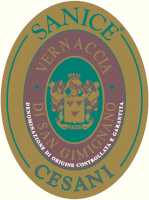
|
|
Vernaccia di San Gimignano Riserva Sanice 2019 |
|
| Cesani (Tuscany, Italy) | |
 Vernaccia di San Gimignano Vernaccia di San Gimignano | |
| Price: € 18.00 | Score: |
 Intense straw yellow and nuances of golden yellow, very transparent. Intense straw yellow and nuances of golden yellow, very transparent. Intense, clean, pleasing, refined and elegant, starts with hints of
plum, apple and hawthorn followed by aromas of broom, citron, pear,
pineapple, medlar, peach, hazelnut, honey and almond. Intense, clean, pleasing, refined and elegant, starts with hints of
plum, apple and hawthorn followed by aromas of broom, citron, pear,
pineapple, medlar, peach, hazelnut, honey and almond.
 Crisp attack and however balanced by alcohol, good body, intense
flavors, pleasing roundness. Crisp attack and however balanced by alcohol, good body, intense
flavors, pleasing roundness.
 Persistent finish with flavors of plum, apple and almond. Persistent finish with flavors of plum, apple and almond. 12 months in steel tanks, 18 months in bottle. 12 months in steel tanks, 18 months in bottle. |
|
 Stuffed pasta with fish, Roasted fish, Roasted white meat, Mushroom soups, Legume soups Stuffed pasta with fish, Roasted fish, Roasted white meat, Mushroom soups, Legume soups |
|
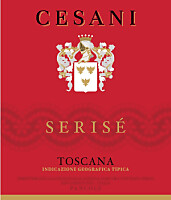
|
|
Serisè 2019 |
|
| Cesani (Tuscany, Italy) | |
 Ciliegiolo Ciliegiolo | |
| Price: € 16.00 | Score: |
 Intense ruby red and nuances of ruby red, little transparency. Intense ruby red and nuances of ruby red, little transparency. Intense, clean, pleasing and refined, starts with hints of cherry,
raspberry and violet followed by aromas of blueberry, plum, tobacco,
chocolate, mace, clove, vanilla and menthol. Intense, clean, pleasing and refined, starts with hints of cherry,
raspberry and violet followed by aromas of blueberry, plum, tobacco,
chocolate, mace, clove, vanilla and menthol.
 Properly tannic attack and however balanced by alcohol, good body,
intense flavors, agreeable. Properly tannic attack and however balanced by alcohol, good body,
intense flavors, agreeable.
 Persistent finish with flavors of cherry, raspberry and blueberry. Persistent finish with flavors of cherry, raspberry and blueberry. 12 months in barrique, 6 months in bottle. 12 months in barrique, 6 months in bottle. |
|
 Stuffed pasta with meat and mushrooms, Stewed meat with mushrooms, Broiled meat and barbecue Stuffed pasta with meat and mushrooms, Stewed meat with mushrooms, Broiled meat and barbecue |
|
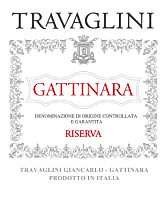
|
|
Gattinara Riserva 2017 |
|
| Travaglini (Piedmont, Italy) | |
 Nebbiolo Nebbiolo | |
| Price: € 35.00 | Score: |
 Intense garnet red and nuances of brick red, moderate transparency. Intense garnet red and nuances of brick red, moderate transparency. Intense, clean, pleasing, refined and elegant, starts with hints of
cherry, strawberry and dried violet followed by aromas of dried rose,
raspberry, strawberry, cinnamon, cocoa, tobacco, sandal, licorice, juniper,
thyme, leather, vanilla and menthol. Intense, clean, pleasing, refined and elegant, starts with hints of
cherry, strawberry and dried violet followed by aromas of dried rose,
raspberry, strawberry, cinnamon, cocoa, tobacco, sandal, licorice, juniper,
thyme, leather, vanilla and menthol.
 Properly tannic attack and however balanced by alcohol, full body,
intense flavors, pleasing crispness. Properly tannic attack and however balanced by alcohol, full body,
intense flavors, pleasing crispness.
 Very persistent finish with long flavors of cherry, plum and raspberry. Very persistent finish with long flavors of cherry, plum and raspberry. About 40 months in cask, 10 months in bottle. About 40 months in cask, 10 months in bottle. |
|
 Game, Roasted meat, Stewed and braised meat with mushrooms, Hard cheese Game, Roasted meat, Stewed and braised meat with mushrooms, Hard cheese |
|
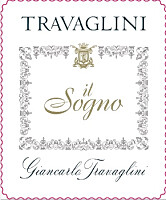
|
|
Il Sogno 2018 |
|
| Travaglini (Piedmont, Italy) | |
 Nebbiolo Nebbiolo | |
| Price: € 60.00 | Score: |
 Brilliant ruby red and nuances of garnet red, little transparency. Brilliant ruby red and nuances of garnet red, little transparency. Intense, clean, pleasing, refined and elegant, starts with hints of
cherry, plum and dried violet followed by aromas of dried rose, raspberry,
strawberry, tamarind, cinnamon, cocoa, tobacco, leather, vanilla and
menthol. Intense, clean, pleasing, refined and elegant, starts with hints of
cherry, plum and dried violet followed by aromas of dried rose, raspberry,
strawberry, tamarind, cinnamon, cocoa, tobacco, leather, vanilla and
menthol.
 Tannic attack and however balanced by alcohol, full body, intense
flavors, agreeable. Tannic attack and however balanced by alcohol, full body, intense
flavors, agreeable.
 Very persistent finish with long flavors of cherry, plum and
raspberry. Very persistent finish with long flavors of cherry, plum and
raspberry.
 Produced with dried grapes. 36 months in cask, 8 months in barrique. Produced with dried grapes. 36 months in cask, 8 months in barrique. |
|
 Game, Stewed and braised meat with mushrooms, Roasted meat, Hard cheese Game, Stewed and braised meat with mushrooms, Roasted meat, Hard cheese |
|
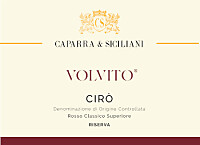
|
|
Cirò Rosso Classico Superiore Riserva Volvito 2019 |
|
| Caparra & Siciliani (Calabria, Italy) | |
 Gaglioppo Gaglioppo | |
| Price: € 15.00 | Score: |
 Intense ruby red and nuances of garnet red, little transparency. Intense ruby red and nuances of garnet red, little transparency. Intense, clean, pleasing, refined and elegant, starts with hints of
plum, black cherry and dried violet followed by aromas of strawberry,
blueberry, carob, cocoa, black pepper, tobacco, leather, mace, vanilla and
menthol. Intense, clean, pleasing, refined and elegant, starts with hints of
plum, black cherry and dried violet followed by aromas of strawberry,
blueberry, carob, cocoa, black pepper, tobacco, leather, mace, vanilla and
menthol.
 Properly tannic attack and however balanced by alcohol, good body,
intense flavors, agreeable. Properly tannic attack and however balanced by alcohol, good body,
intense flavors, agreeable.
 Persistent finish with flavors of plum, black cherry and strawberry. Persistent finish with flavors of plum, black cherry and strawberry. 24 months in barrique, 6 months in bottle. 24 months in barrique, 6 months in bottle. |
|
 Roasted meat, Stewed meat with mushrooms, Broiled meat and barbecue Roasted meat, Stewed meat with mushrooms, Broiled meat and barbecue |
|
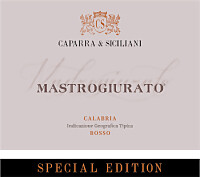
|
|
Mastrogiurato Special Edition 2019 |
|
| Caparra & Siciliani (Calabria, Italy) | |
 Gaglioppo (70%), Greco Nero (30%) Gaglioppo (70%), Greco Nero (30%) | |
| Price: € 19.50 | Score: |
 Intense ruby red and nuances of garnet red, little transparency. Intense ruby red and nuances of garnet red, little transparency. Intense, clean, pleasing, refined and elegant, starts with hints of
plum, blackberry and dried violet followed by aromas of carnation, black
cherry, blueberry, cocoa, tobacco, cinnamon, leather, licorice, mace, black
pepper, vanilla and menthol. Intense, clean, pleasing, refined and elegant, starts with hints of
plum, blackberry and dried violet followed by aromas of carnation, black
cherry, blueberry, cocoa, tobacco, cinnamon, leather, licorice, mace, black
pepper, vanilla and menthol.
 Properly tannic attack and however balanced by alcohol, good body,
intense flavors, agreeable. Properly tannic attack and however balanced by alcohol, good body,
intense flavors, agreeable.
 Persistent finish with flavors of plum, blackberry and black cherry. Persistent finish with flavors of plum, blackberry and black cherry. 1 year in barrique, 6 months in bottle. 1 year in barrique, 6 months in bottle. |
|
 Roasted meat, Stewed meat with mushrooms, Broiled meat and barbecue, Cheese Roasted meat, Stewed meat with mushrooms, Broiled meat and barbecue, Cheese |
|
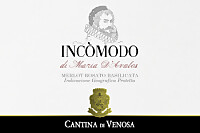
|
|
Incomodo 2021 |
|
| Cantina di Venosa (Basilicata, Italy) | |
 Merlot Merlot | |
| Price: € 11.00 | Score: |
 Intense onion skin pink and nuances of cherry pink, transparent. Intense onion skin pink and nuances of cherry pink, transparent. Intense, clean, pleasing and refined, starts with hints of cherry,
raspberry and plum followed by aromas of cyclamen, rose, pomegranate,
blueberry, strawberry, bergamot and vanilla. Intense, clean, pleasing and refined, starts with hints of cherry,
raspberry and plum followed by aromas of cyclamen, rose, pomegranate,
blueberry, strawberry, bergamot and vanilla.
 Crisp attack and however balanced by alcohol, good body, intense
flavors, pleasing roundness. Crisp attack and however balanced by alcohol, good body, intense
flavors, pleasing roundness.
 Persistent finish with flavors of cherry, raspberry and plum. Persistent finish with flavors of cherry, raspberry and plum. Aged in steel tanks and barrique. Aged in steel tanks and barrique. |
|
 Pasta with meat, Broiled fish, Roasted white meat, Mushroom and legume soups, Cheese Pasta with meat, Broiled fish, Roasted white meat, Mushroom and legume soups, Cheese |
|
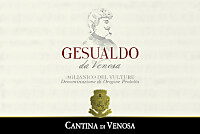
|
|
Aglianico del Vulture Gesualdo da Venosa 2019 |
|
| Cantina di Venosa (Basilicata, Italy) | |
 Aglianico Aglianico | |
| Price: € 15.00 | Score: |
 Deep ruby red and nuances of garnet red, little transparency. Deep ruby red and nuances of garnet red, little transparency. Intense, clean, pleasing, refined and elegant, starts with hints of
plum, black cherry and blackberry followed by aromas of dried violet, dried
rose, carob, tobacco, cocoa, licorice, leather, mace, pink pepper, vanilla
and menthol. Intense, clean, pleasing, refined and elegant, starts with hints of
plum, black cherry and blackberry followed by aromas of dried violet, dried
rose, carob, tobacco, cocoa, licorice, leather, mace, pink pepper, vanilla
and menthol.
 Properly tannic attack and however balanced by alcohol, full body,
intense flavors, agreeable. Properly tannic attack and however balanced by alcohol, full body,
intense flavors, agreeable.
 Persistent finish with flavors of plum, black cherry and blackberry. Persistent finish with flavors of plum, black cherry and blackberry. 9 months in cask and steel tanks, at least 4 months in bottle. 9 months in cask and steel tanks, at least 4 months in bottle. |
|
 Game, Stewed and braised meat, Roasted meat, Hard cheese Game, Stewed and braised meat, Roasted meat, Hard cheese |
|
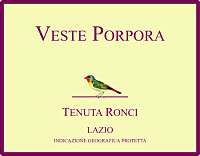
|
|
Veste Porpora 2020 |
|
| Tenuta Ronci di Nepi (Latium, Italy) | |
 Cabernet Sauvignon, Merlot Cabernet Sauvignon, Merlot | |
| Price: € 12.00 | Score: |
 Deep ruby red and nuances of purple red, little transparency. Deep ruby red and nuances of purple red, little transparency. Intense, clean, pleasing, refined and elegant, starts with hints of
black currant, black cherry and plum followed by aromas of violet, iris,
blueberry, carob, chocolate, tobacco, mace, pink pepper, cinnamon, vanilla
and menthol. Intense, clean, pleasing, refined and elegant, starts with hints of
black currant, black cherry and plum followed by aromas of violet, iris,
blueberry, carob, chocolate, tobacco, mace, pink pepper, cinnamon, vanilla
and menthol.
 Properly tannic attack and however balanced by alcohol, good body,
intense flavors, pleasing roundness. Properly tannic attack and however balanced by alcohol, good body,
intense flavors, pleasing roundness.
 Persistent finish with flavors of black currant, black cherry and plum. Persistent finish with flavors of black currant, black cherry and plum. 15 months in barrique. 15 months in barrique. |
|
 Broiled meat and barbecue, Roasted meat, Stewed meat with mushrooms, Cheese Broiled meat and barbecue, Roasted meat, Stewed meat with mushrooms, Cheese |
|
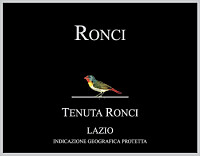
|
|
Ronci 2019 |
|
| Tenuta Ronci di Nepi (Latium, Italy) | |
 Cabernet Sauvignon Cabernet Sauvignon | |
| Price: € 22.00 | Score: |
 Deep ruby red and nuances of ruby red, little transparency. Deep ruby red and nuances of ruby red, little transparency. Intense, clean, pleasing, refined and elegant, starts with hints of
black currant, black cherry and blueberry followed by aromas of violet,
peony, blueberry, blackberry, tamarind, chocolate, tobacco, leather,
vanilla and eucalyptus. Intense, clean, pleasing, refined and elegant, starts with hints of
black currant, black cherry and blueberry followed by aromas of violet,
peony, blueberry, blackberry, tamarind, chocolate, tobacco, leather,
vanilla and eucalyptus.
 Properly tannic attack and however balanced by alcohol, good body,
intense flavors, agreeable. Properly tannic attack and however balanced by alcohol, good body,
intense flavors, agreeable.
 Persistent finish with flavors of black currant, black cherry and
blueberry. Persistent finish with flavors of black currant, black cherry and
blueberry.
 24 months in barrique. 24 months in barrique. |
|
 Game, Stewed and braised meat with mushrooms, Roasted meat, Cheese Game, Stewed and braised meat with mushrooms, Roasted meat, Cheese |
|

|
|
Inkiostro 2015 |
|
| Valori (Abruzzo, Italy) | |
 Merlot Merlot | |
| Price: € 21.10 | Score: |
 Deep ruby red and nuances of garnet red, little transparency. Deep ruby red and nuances of garnet red, little transparency. Intense, clean, pleasing, refined and elegant, starts with hints of
black currant, plum and black cherry followed by aromas of dried violet,
peony, blueberry, tobacco, cocoa, leather, licorice, carob, mace, vanilla,
graphite and eucalyptus. Intense, clean, pleasing, refined and elegant, starts with hints of
black currant, plum and black cherry followed by aromas of dried violet,
peony, blueberry, tobacco, cocoa, leather, licorice, carob, mace, vanilla,
graphite and eucalyptus.
 Properly tannic attack and however balanced by alcohol, full body,
intense flavors, pleasing roundness. Properly tannic attack and however balanced by alcohol, full body,
intense flavors, pleasing roundness.
 Persistent finish with flavors of black currant, plum and black cherry. Persistent finish with flavors of black currant, plum and black cherry. 12 months in barrique, at least 12 months in bottle. 12 months in barrique, at least 12 months in bottle. |
|
 Game, Roasted meat, Stewed meat, Cheese Game, Roasted meat, Stewed meat, Cheese |
|

|
|
Montepulciano d'Abruzzo Riserva Vigna Sant'Angelo 2015 |
|
| Valori (Abruzzo, Italy) | |
 Montepulciano Montepulciano | |
| Price: € 21.10 | Score: |
 Deep ruby red and nuances of garnet red, impenetrable to light. Deep ruby red and nuances of garnet red, impenetrable to light. Intense, clean, pleasing, refined and elegant, starts with hints of
plum, black cherry and blueberry followed by aromas of dried violet,
blackberry, black currant, cocoa, carob, tobacco, licorice, leather, mace,
graphite, vanilla and menthol. Intense, clean, pleasing, refined and elegant, starts with hints of
plum, black cherry and blueberry followed by aromas of dried violet,
blackberry, black currant, cocoa, carob, tobacco, licorice, leather, mace,
graphite, vanilla and menthol.
 Properly tannic attack and however balanced by alcohol, full body,
intense flavors, agreeable. Properly tannic attack and however balanced by alcohol, full body,
intense flavors, agreeable.
 Persistent finish with flavors of plum, black cherry and blueberry. Persistent finish with flavors of plum, black cherry and blueberry. 12 months in barrique, at least one year in bottle. 12 months in barrique, at least one year in bottle. |
|
 Game, Roasted meat, Stewed and braised meat, Hard cheese Game, Roasted meat, Stewed and braised meat, Hard cheese |
|

|
|
Vermentino di Gallura Spera 2021 |
|
| Siddura (Sardinia, Italy) | |
 Vermentino Vermentino | |
| Price: € 13.00 | Score: |
 Brilliant straw yellow and nuances of straw yellow, very transparent. Brilliant straw yellow and nuances of straw yellow, very transparent. Intense, clean, pleasing and refined, starts with hints of apple,
pineapple and hawthorn followed by aromas of broom, plum, pear, passion
fruit, tangerina, peach and almond. Intense, clean, pleasing and refined, starts with hints of apple,
pineapple and hawthorn followed by aromas of broom, plum, pear, passion
fruit, tangerina, peach and almond.
 Crisp attack and however balanced by alcohol, good body, intense
flavors, agreeable. Crisp attack and however balanced by alcohol, good body, intense
flavors, agreeable.
 Persistent finish with flavors of apple, plum and pineapple. Persistent finish with flavors of apple, plum and pineapple. Aged in steel tanks. Aged in steel tanks. |
|
 Pasta with fish and crustaceans, Fried fish, Sauteed fish, Dairy products Pasta with fish and crustaceans, Fried fish, Sauteed fish, Dairy products |
|

|
|
Cannonau di Sardegna Riserva Fola 2019 |
|
| Siddura (Sardinia, Italy) | |
 Cannonau Cannonau | |
| Price: € 22.00 | Score: |
 Intense ruby red and nuances of garnet red, little transparency. Intense ruby red and nuances of garnet red, little transparency. Intense, clean, pleasing, refined and elegant, starts with hints of
plum, black cherry and dried violet followed by aromas of blackberry,
blueberry, carob, chocolate, cinnamon, tobacco, mace, thyme, vanilla and
menthol. Intense, clean, pleasing, refined and elegant, starts with hints of
plum, black cherry and dried violet followed by aromas of blackberry,
blueberry, carob, chocolate, cinnamon, tobacco, mace, thyme, vanilla and
menthol.
 Properly tannic attack and however balanced by alcohol, good body,
intense flavors, agreeable. Properly tannic attack and however balanced by alcohol, good body,
intense flavors, agreeable.
 Persistent finish with flavors of plum, black cherry and blackberry. Persistent finish with flavors of plum, black cherry and blackberry. Aged in cask. Aged in cask. |
|
 Stuffed pasta, Broiled meat and barbecue, Roasted meat, Stewed meat with mushrooms, Hard cheese Stuffed pasta, Broiled meat and barbecue, Roasted meat, Stewed meat with mushrooms, Hard cheese |
|
News |
|
In this section are published news and information about events concerning the world of wine and food. Whoever is interested in publishing this kind of information can send us a mail to our address.
|
AquavitaeReview of Grappa, Distillates and Brandy |
|
|
||||||||||||
Wine Guide ParadeFebruary 2023
|
| |||||||
Privacy Policy | |||||||


| Copyright © 2002-2024 Antonello Biancalana, DiWineTaste - All rights reserved |
| All rights reserved under international copyright conventions. No part of this publication and of this WEB site may be
reproduced or utilized in any form or by any means, electronic or mechanical, without permission in writing from DiWineTaste. |